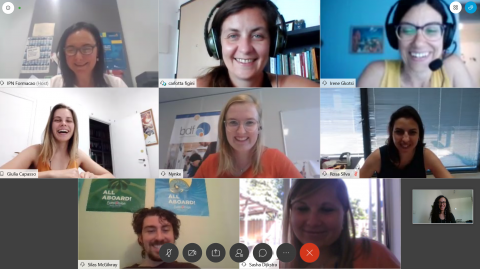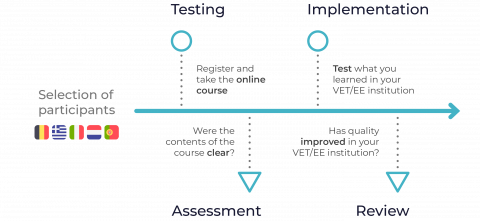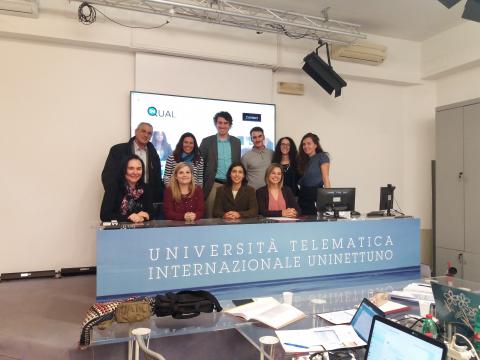3.4 - EU networks for VET providers: learning, exchanging, cooperating
Abstract
While your VET institution and its quality management system might be in perfect working order,
there is always something you can learn from others as a Quality Manager, especially in contexts
where many different providers and stakeholders come together. Participating in external networks,
especially at EU level, is a way to offer VET staff as well as students interesting opportunities for
learning, exchange and cooperation, as well as to improve the quality of your VET provision.
Why is this important for you as a QM?
- To foster internationalisation and the exchange of good practices among countries;
- To have your voice heard at EU level on issues that you care about;
- To connect with other VET providers and explore opportunities for cooperation;
- To create learning opportunities for teachers and staff;
- To bring a European dimension into your VET institution.
How should I implement the action?
As a Quality Manager, you can play an important role in identifying external networks that suit the
needs and ambitions of your VET institution. Some of the following networks are dedicated spaces for
teachers and experts to share best practices and provide EU bodies with useful input “from the
ground”; you can direct relevant staff members to one of the following:
- Networks for teachers:
- eTwinning: an online platform for school staff (44 EU and extra-EU countries involved) to communicate, collaborate, develop and share projects. eTwinning is available in 28 languages and offers free professional development opportunities for teachers, information about recognition, examples of successful projects, 14 thematic groups (including one on entrepreneurship in education) and various other opportunities to connect with teachers online and exchange good practices.
- School Education Gateway: a broader online platform open not only to teachers but also to policy-makers, experts and other education professionals. Available in 23 European languages, it offers a variety of resources including updates on EU education policy developments, experts’ opinions, publications, teaching materials and nine thematic pages (including one on entrepreneurship education). School Education Gateway also offers support in improving inclusiveness and preventing early school leaving (through a dedicated European Toolkit for Schools) and provides information on professional development opportunities offered either by independent course providers or through EU funding schemes.
- Networks for experts and other education stakeholders:
- Cedefop networks: Cedefop is a decentralised agency of the European Union that focuses on the development and implementation of vocational training and education policies. Cedefop manages several thematic networks:
- Ambassadors tackling early leaving in VET: established in 2017 as a supporting network for Cedefop’s VET Toolkit for tackling early leaving, it sees the participation of a variety of ambassadors (policy makers, learning providers, experts, other key stakeholders) involved in tackling early leaving for VET at national, regional or local levels in Europe;
- CareersNet: a network created to collect comparable and reliable information on a European scale in the field of lifelong guidance and career development, and to identify related gaps and solutions;
- Cedefop community of apprenticeship experts: a voluntary-based network of experts aiming to collect and compare key information on apprenticeships in Europe;
- European community of learning providers: set up in 2017 by Cedefop and six other EU-level VET associations, it is meant to complement the Platform for European associations of VET providers created by DG EMPL to provide policy advice to the European Commission;
- ReferNet: a network of institutions established in 2002 to provide in-depth information on national vocational and training systems and policies in the EU Member States, Iceland and Norway, with a focus on how each country is progressing in its implementation of common European policy objectives;
- Skillsnet: a network of researchers and experts active in early identification of skill needs and forecasting or in the transfer of research results of future skill requirements into policy and practice.
- ET2020 Working Group on Vocational Education and Training: one of seven Working Groups created in 2018 to support policy-making at the EU and national level; members of the Working Groups are government officials appointed by EU Member States but also include representatives of selected stakeholder organisations and social partners.
- Cedefop networks: Cedefop is a decentralised agency of the European Union that focuses on the development and implementation of vocational training and education policies. Cedefop manages several thematic networks:
Other EU networks bring together VET providers and/or associations thereof with the objective of gathering aggregated inputs from the national level and shaping EU policy accordingly. As a Quality Manager, you can become the liaison person between your VET institute and networks such as:
- Networks for VET institutions and associations:
- EQAVET network: a platform for deepening cooperation in quality in VET by bringing together European VET stakeholders and promoting a unified ‘toolbox’ of quality criteria and indicators. National Reference Points are the appointed links between the EQAVET network and VET institutions and stakeholders interested in joining the network or in learning more about the framework.
- JA Europe: a non-profit organisation offering entrepreneurship programmes that aim to inspire and prepare young people to succeed in a global economy. The JA Europe network counts almost 40 000 schools across 40 countries. JA Europe is a member of the wider JA Worldwide network.
- EE-HUB: a specialised international network which brings together European and national governments, businesses, NGOs, researchers and educators with the objective of increasing the quantity, quality and impact of entrepreneurship education in Europe. EE-HUB’s activities include connecting EE experts across Europe, tracking key policy developments in VET, providing orientation and training through professional workshops and initiatives, and advocating for entrepreneurship education at EU level.
- EfVET (European Forum of Technical and Vocational Education and Training): a European association created by and for VET providers with the objective of championing and enriching technical and vocational education and training through transnational cooperation. EfVET represents 25 EU countries, 200 learning providers, over 1500 VET institutions and more than 2 million learners.
- EVTA (European Vocational Training Association): a network of European organisations in the field of human capital development. EVTA counts 12 members representing public and private VET providers and companies acting at international, national and regional levels.
- EVBB (European Association of Institutes for Vocational Training): a European network of associations, coordinating institutes of education and VET providers which aims to improve the quality of VET provision in Europe. EVBB counts 55 members from EU and extra-EU countries representing 35 000 staff members and 1 500 educational centres.
How should I know if I have made an impact thus increasing the quality of the VET provision and to which extent? (Indicators also linked with the EQAVET if any):
- If the action has been successfully implemented, the VET provider will register quality improvement in the areas of interest of the network it has decided to join. A few examples include:
- An active involvement of teachers in the online communities of eTwinning and School Education Gateway, which have a strong focus on the issue of early school leaving, may result in an increase in the completion rate of VET programmes (measured by EQAVET indicator n. 4);
- Exploring the professional development opportunities highlighted by School Education Gateway may facilitate the implementation of staff trainings (measured by EQAVET indicator n.2);
- Joining a European network of VET providers and sharing expertise on bridging the gap between school and the labour market may result in an increase in the placement rate of VET programmes (measured by EQAVET indicator n. 5).
- In general terms, this action can be considered successfully implemented if the benefits derived from joining an external network surpass the relative investment in terms of money, time or resources
Links & further readings (includes also third-party resources- videos, etc.):
Cedefop recommends the following publications to VET providers looking for international cooperation:
- Cedefop (2008), Terminology of European education and training policy: a selection of 100 key terms;
- Cedefop (2011), Assuring quality in vocational education and training: the role of accrediting VET providers;
- Cedefop (2011), Glossary: quality in education and training.



